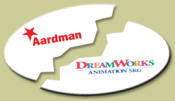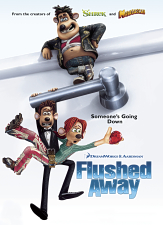 Despite several rebuttals from both DreamWorks and Aardman themselves, the story that we reported at Animated News last October has sadly turned out to be true, and it was confirmed this week by DWs honcho Jeffrey Katzenberg that the pair are to split.
Despite several rebuttals from both DreamWorks and Aardman themselves, the story that we reported at Animated News last October has sadly turned out to be true, and it was confirmed this week by DWs honcho Jeffrey Katzenberg that the pair are to split.
This not only proves the old adage that “there’s no smoke without fire”, but that the bottom line rules all: no doubt the companies were eager to quash the rumors as nothing more than speculation fodder in the run up to their joint production Flushed Away hitting theaters so as to not affect the film’s box office chances. But DreamWorks share-holder Paul Allen didn’t do much to keep the mill turning when he filed for more shares of the company to be sold, widely seen as an eleventh hour bid to run up some cash before Flushed (unfortunate tagline: “Someone’s Going Down”) hit theaters and took its anticipated fall.
 Actually, for a British-set movie featuring yet more lovable animated critters – plus in this case the hard to sell case of rodent stars – and with a fairly light premise, Flushed Away didn’t do too badly, racking up $62m in the US, and $171m worldwide…surely not the numbers of a box office bomb. But that evidently wasn’t enough to appease DreamWorks, who look set to take a $105m writedown on the film, and insisted on moving production to its Glendale studio and converting the traditional Aardman claymation approach to their own computer animation systems.
Actually, for a British-set movie featuring yet more lovable animated critters – plus in this case the hard to sell case of rodent stars – and with a fairly light premise, Flushed Away didn’t do too badly, racking up $62m in the US, and $171m worldwide…surely not the numbers of a box office bomb. But that evidently wasn’t enough to appease DreamWorks, who look set to take a $105m writedown on the film, and insisted on moving production to its Glendale studio and converting the traditional Aardman claymation approach to their own computer animation systems.
Did the marriage of the quirky Brit studio with its own ways of working and the tough, Hollywood streamlined factory machine ever really stand a chance? Their first collaboration, Chicken Run looks more than a fluke by comparison. That was also released, of course, at a time when we were not as swamped with animated films – talking critter stuffed or not – and as such instantly held a more unique attraction. However, we must remember that Chicken Run, too, only managed to scape by the $100 million barrier, and that was without the onslaught of competition coming at it from all sides as was witnessed by the almost-bloodbath of similar, competitive releases last year.
Well, at least Aardman were able to provide awards recognition for their American partners, right? Um…no. True that the claymation masters had accumulated a number of awards, including many from the all-important Motion Picture Academy themselves, and which made them an attractive proposition to DreamWorks in the first place. And there was the Wallace & Gromit bonus too, with the prospect of transferring those immensely popular characters to the big screen in their first feature. But in reality, it seems, awards are all well and good as long as they translate to a boost in sales, and the Wallace & Gromit movie, though well anticipated and reviewed, failed to match the popularity enjoyed by its small-screen, featurette-sized predecessors, and a win for Best Animated Feature did little to push sales of the DVD, where it even lost out to Disney’s direct-to-video offering Bambi II in their joint first week release.
The cracks were obviously already beginning to show. Aardman were famous for not making concessions in their very British-minded movies, while DreamWorks pushed for a more international flavor. Production on any movie can be a struggle, but again there is usually no smoke without fire, and the word on Flushed Away was more “troubled” than usual. Step one in the breakup of the partnership seems to have been the choice to work in CGI, supposedly a story-driven decision dictated by the huge sets and water-heavy scenes required by the script.
Although Aardman’s own Nick Park wasn’t involved with Flushed, he made it clear that he wasn’t in favor of the technique, or of abandoning what made his company unique. I know I was also disappointed that Aardman seemed to be jumping on the CG wagon, and questioned why the characters couldn’t have been hand-animated and placed into their computer designed world. Perhaps it was a question of expense (as opposed to being seen as pioneering challenge); the ugly “money” word again raised to protect the bottom line.
Yes, it is a question of art versus commerce – especially it seems nowadays in the animation medium where computers apparently haven’t made things that much easier. But what’s the point of going to a claymation supplier and turning what they do best into another CGI animation clone? Flushed Away was, unfairly or not, dead in its CG waters on arrival, at least artistically. Rumors were rife that the two studios would be parting ways, something that was refuted by both companies but not dealt with by way of an official denial by any means. Where would a split leave them? For DreamWorks, who have just appropriately revealed a new business model, it fits within their plans to cut back on the quantity and up the quality. For Aardman, the question mark looms larger, and they certainly have the poorer hand to play. But their track record is still impressive, and their reputation as consummate filmmakers is assured, even if their previous library is tied up with their old partners. However, they shouldn’t really have a hard time finding new distribution opportunities and could even bounce back more successfully.
Where does this leave their projects though? Long in gestation (and another title fueling the reported bickering stories over the years) has been Tortoise And The Hare, for which Michael Caine is reported to have already recorded his voice for, and previously announced was John Cleese’s caveman spoof Crood Awakening. Are these joint-development projects, or does Aardman have carte blanche to deliver them elsewhere? And what about Cleese’s professional ties with DreamWorks and their Shrek franchise? As with any relationship breakup, there looks like there could be the odd casualty or two.
But now, at least, we know where things stand, and it was finally reported that the split was official. I find it not only convenient that the news comes as DreamWorks unveiled its new “movie-and-a-sequel-a-year” model, but also so close after last week’s Oscar nominations. Could a nod for Academy darlings Aardman’s Flushed Away have kept the two companies on track for at least one more movie? Certainly, the five-picture deal the pair originally signed up for has resulted in just three films.
Hearing DreamWorks’ Katzenberg raving about Aardman’s work while cutting their contact short rings a little hollow – why not simply re-up the move to making better movies and include their prestigious partner along for the ride? Aardman is very clear in the direction they want to head, and a read between the lines in their statement reveals much more on the matter of Flushed‘s production, when they remarked that their previous partner “is now dedicated to making two CG movies a year, and we (at Aardman) want to and will continue to make 3D model movies”.
All of which proves the sad fact that the entertainment industry is a numbers game. Already, Flushed Away‘s DVD projections have been halved and DreamWorks doesn’t expect to make anything back on the venture, after it had previously expected to merely “break even” on the project.
I wish both companies the best of luck with their future plans, and would only say to those who might look to “blame” DreamWorks for the split that this is nothing personal. It’s only business.
– Ben.

